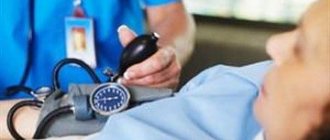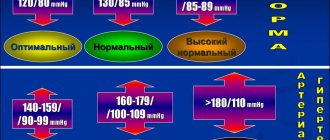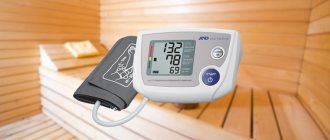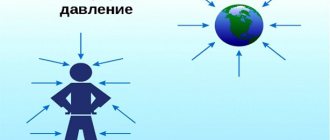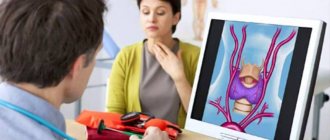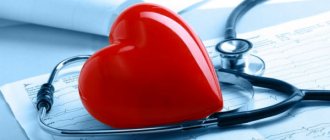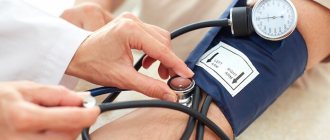One of the most popular topics in medical publications and television programs is hypertension - high blood pressure. And this is not surprising, because this disease is extremely dangerous and very widespread. But there is another pathology associated with blood pressure - hypotension, a condition when the pressure is below normal.
Hypotension does not threaten such dire consequences as hypertension, which is probably why it receives much less attention, and doctors, having discovered low blood pressure in their patient, in many cases do not give it due importance. Meanwhile, the state of health of a hypotensive person - a person with low blood pressure - cannot be called good.
What pressure can be considered low?
If the pressure exceeds 139 per 90 mmHg, doctors clearly define it as elevated. But for low pressure such an exact value does not exist. However, most doctors consider low blood pressure to be less than 100 (systolic or “upper”) by 60 (diastolic or “lower”) millimeters of mercury.
It is not always fair to regard hypotension as a pathological process.
For many people, low blood pressure is a kind of norm. For these people, this physiological feature does not cause any discomfort. This is often observed in children, adolescents, young women, as well as in athletes and ballerinas. But still, for a large number of people, due to low blood pressure, their well-being deteriorates quite noticeably, as well as their performance. And it is possible and necessary to fight this.
What diseases cause blood pressure levels to decrease?
Diseases associated with the cardiovascular system
| Name | How does it manifest? |
| Pulmonary embolism | This means that the patient’s pulmonary artery began to become clogged with a thrombus from the inferior pudendal vein subsystem. Due to pulmonary embolism, acute hypotension occurs. |
| VSD | High blood pressure with vegetative-vascular dystonia (hypotonic type) is not always observed. The disease is associated with the predominance of parasympathetic influx over sympathetic. The adrenal glands produce more acetylcholine than needed. With VSD, the patient feels irritability, weakness, weakness, and fever. |
| Cerebral atherosclerosis | Cerebral atherosclerosis does not cause problems with low blood pressure in all people. This type mainly develops in the elderly. |
| Heart problems | Disorganization of the heart rhythm, which is generated by the pathology of nervous regulation, can greatly reduce heart pressure. As a result, cardiac arrhythmia appears. Taking medications for these diseases can lower blood pressure (nitroglycerin, antibiotics, antispasmodics). |
| Decreased blood volume | Constantly low blood pressure in heart failure. It develops from myocarditis, endocarditis of various origins. Hypotension is directly related to the inability to transport blood in sufficient quantities through the blood vessels to the heart and brain. The tone in the vessels causes a sharp decrease in pressure. A reduced blood volume indicates the development of certain complications that should be prevented. Blood pressure drops when blood is lost. This is observed in young girls and women with heavy periods. When losing blood (bleeding from the nose, mouth, uterus), a person feels a loss of strength. This blood pressure dropped. |
Other ailments that cause low blood pressure
| Name | How does it manifest? |
| Anaphylactic shock and heat stroke | When an allergy to the administered medication develops, anaphylactic shock develops. During shock, the vascular walls expand. Blood from large vessels enters smaller ones. Thus the pressure drops. The same effect occurs from overheating of the body. But, unlike anaphylactic shock, not only a doctor can help. You can cope with heatstroke yourself. |
| Other | Pregnant women may experience low blood pressure during toxicosis. This is a direct threat to the life of mother and child. But if the woman had hypotension before, then the disease does not mean anything terrible for the pregnant woman. However, for the unborn baby the risk remains, because in this way the baby’s intrauterine pressure is reduced. An attack of low blood pressure is observed after taking a steam bath or sauna. But if you wait time, the pressure will return to normal. |
How do hypotensive people live?
Low blood pressure begins to manifest itself from the first minutes of waking up in the morning: hypotensive patients get out of bed lethargic, not rested, often with a headache. During the day, they are constantly overcome by the desire to sleep, and it is difficult for them to force themselves to work.
Absent-mindedness, inability to concentrate, fatigue, drowsiness, lethargy and apathy, low performance and emotional instability, manifested by irritability - these are the main symptoms of this disease.
But often hypotensive patients also complain of pain in the joints and muscles, sweating, unstable stools, and heartburn. Many people are worried about insomnia.
Complaints of frequent dizziness and migraine-type headaches with nausea and vomiting are also typical.
By the way, it is sometimes possible to relieve such a headache without pills: it decreases after walking in the fresh air and physical exercise, rubbing the temple areas with vinegar or applying ice or a towel soaked in cold water to the head.
Prerequisites leading to a drop in blood pressure levels
It is possible to answer the question of why a person’s blood pressure decreases and what are the reasons for the progression of this condition only after a comprehensive study. In the vast majority of cases, problems with the cardiovascular or nervous system are the root cause of the development of hypotension.
A drop in blood pressure readings can occur under the following unfavorable circumstances:
- Change in the actual amount of blood in the body. A sharp drop in indicators is quite logical in case of massive bleeding, rapid dehydration;
- Slowing of the heart (decreased strength of contraction of the heart muscle). The organ pushes out blood poorly or the fluid fractions are too small. A sudden decrease in blood pressure and all subsequent symptoms can occur if a person suddenly gets out of bed in the morning after sleep. This can be encountered by those who have been in one static position for a long time, and then suddenly change their position or begin to make active movements;
- Infectious diseases;
- Due to negative factors of external or internal origin, the nerve endings that control blood pressure at a basic level may suffer.
To talk about hypotension, in particular when blood pressure drops suddenly and too quickly, is a serious problem in two cases. For pregnant women, too low blood pressure readings are fraught with abnormal phenomena during pregnancy itself, as well as problems faced by the fetus. The unborn child is in a state of chronic hypoxia. In such conditions, normal development and growth is impossible.
Hypotension, like hypertension, in elderly people can provoke ischemic processes and stroke conditions. It has been noted that a sudden drop in blood pressure during sleep in patients of the older age group can result in loss of hearing or vision. During the daytime, strokes and heart attacks, as well as other pathological processes of this kind, occur more often.
The causes of low blood pressure in a hypertensive person and an ordinary healthy person can be certain conditions associated with key aspects of the physiology of the human body. Simply put, in some situations, blood pressure may drop sharply for a while, and then return to normal again and this will be considered a normal reaction.
These conditions include:
- Heat combined with humid air (beach, bathhouse, public transport in the summer);
- High air temperature in work areas (in workshops, factories, factories, kitchens, offices);
- Regular exercise (subject to extremely high loads);
- Hard physical labor.
A sharp decrease in blood pressure and its symptoms may also indicate pathology. Treatment in this situation is mandatory. The main pathological conditions and circumstances under which hypotensive syndrome may occur:
- Vegetative-vascular dystonia (VSD);
- Cerebral atherosclerosis;
- Hypovolemia of pathological origin;
- Heart pathologies;
- Endocrine diseases;
- Heat (sunstroke) stroke;
- Anemia;
- Pregnancy;
- Injuries (including a history of previous injuries);
- Oncological diseases.
It is also worth considering the hereditary factor. Blood vessels, heart, and nervous systems can often “fail” due to individual susceptibility. For example, one person may experience constant dizziness and headaches, or even faint in a stuffy room. At the same time, the other person will not experience any discomfort in a similar situation.
Circadian rhythms
The level of blood pressure in chronic hypotension is unstable and can change during the day, and along with it the state of health changes.
Usually, a couple of hours after getting up in the morning, hypotensive people slightly revive and feel better. By the middle of the day, the decline in mood and performance begins again, and by the evening the state of health improves again.
In addition, hypotensive patients react very sharply to fluctuations in atmospheric pressure, temperature, and humidity. Many people find it difficult to travel on crowded public transport. Their well-being worsens after a heavy meal, as well as during periods of increased emotional stress. It is interesting that many people feel better on cold days.
Normal for a healthy person
Blood pressure is an important indicator of the condition of the human body. It shows the force of pressure of blood leaving the heart muscle on the walls of blood vessels. For blood pressure, the upper and lower numbers are important. The first shows the force of contraction, compression of the heart at the moment of pushing blood into the arteries. And the lower (diastolic) is an indicator of the strength in the arteries when the heart muscles are in a relaxed state. Between these two indicators is pulse pressure.
All people, depending on their age and body characteristics, may have different blood pressure values. In addition, they depend on weather conditions, time of day, medications taken and stressful situations experienced.
However, for a healthy person, systolic values are considered normal: from 110 to 130 mm. Hg and diastolic - 80-89 mm. Hg If the indicators go beyond these parameters, these are deviations from the norm, which leads to poor health.
There are cases when a person has high or low blood pressure all his life, but this does not affect his well-being in any way. However, if your blood pressure drops sharply, and this process repeats periodically, you need to visit a doctor and undergo the necessary tests to diagnose the source of hypotension.
What are the reasons?
Hypotension may not be an independent condition, but a symptom of a completely different disease: circulatory disorders, cardiovascular failure, infectious diseases, gastric and duodenal ulcers, some respiratory diseases, hormonal imbalance, etc. In this case, to normalize blood pressure, you need to exercise treatment of the underlying disease. Hypotension can also manifest itself in an acute form, requiring immediate assistance, with massive bleeding.
Hypotension, which exists on its own and is not associated with another pathology, is the result of a decrease in vascular tone.
The flow of blood through excessively dilated vessels slows down, because of this, tissues and organs lack the oxygen and nutrients supplied by the blood, and as a result, the overall tone of the body decreases. Many researchers believe that such hypotension is inherited.
Why is blood pressure higher in the morning?
High blood pressure in the morning is observed in 40% of hypertensive patients. To find out the cause of this condition, it is necessary to undergo an examination, on the basis of which the doctor will select an effective treatment.
Blood pressure readings can change as a result of various factors. They are usually low during sleep, but may increase in the morning. This phenomenon is due to the fact that at night the body is completely relaxed. After awakening, all its functions are activated. In addition, blood pressure may increase for the following reasons:
- hereditary factor;
- gender (this condition is often observed among men);
- abuse of salty foods and coffee;
- obesity;
- inactive lifestyle;
- deviations in the functioning of the nervous system;
- presence of bad habits;
- pathology of the kidneys or heart.
The risk group includes people who are constantly in psycho-emotional stress. To be healthy, it is important to learn to rest. Blood pressure may rise in the morning due to emotional disturbances. Patients suffering from neuroses and neurasthenia have an unstable psyche and pressure changes are inevitable for them.
Abdominal obesity is also a risk factor. In this case, fat deposits are noted in the abdominal area, which are significantly different from subcutaneous fat. They are quite aggressive because they secrete a large amount of hormonal substances. To normalize your weight and get yourself in order, you need to adjust your diet. For hypertensive patients, it is very important to minimize the consumption of salty foods. Its excess amount in the body leads to fluid retention, which causes an increase in blood pressure. If your diet is dominated by food with animal fats, this threatens the accumulation of cholesterol. This condition does not have the best effect on the condition of blood vessels.
The reason for the increase in blood pressure in the morning may be the evening meal. If you eat a fatty, high-calorie meal in the evening, you can expect an increase in cholesterol levels, and this, in turn, will affect a jump in blood pressure.
People with glomerulonephritis, pyelonephritis or renal failure are most susceptible to hypertension. Treatment in this case requires not only the use of antihypertensive drugs, but also drugs with a diuretic effect.
The morning pressure surge may be related to weather conditions. During the research, scientists confirmed the fact that cyclones and anticyclones have a strong impact on weather-sensitive people. Due to changes in atmospheric pressure, their health worsens.
Increased blood pressure may be associated with hormonal imbalances in the body. If we talk about the fair sex, then this could be menopause or menstrual cycles. Hormonal imbalance is typical for pregnant women, so they are often diagnosed with high blood pressure. To exclude the presence of serious health problems, you need to undergo a full examination of the body, be sure to check the thyroid gland and the functioning of the adrenal glands. Changes can also be a consequence of some pathological process.
Body position during sleep can also affect how a person feels after waking up. If the posture is uncomfortable, blood circulation worsens, which contributes to an increase in morning pressure. Its stabilization occurs independently after a certain period of time, and no measures are required.
Fainting
One of the common causes of fainting is a decrease in blood pressure. This can happen when quickly getting out of bed, when the blood pressure in the vessels of the brain drops sharply. In such cases, the person needs to be laid down: in a horizontal position, the blood supply to the brain improves and the victim comes to his senses faster. There is no need to put anything under your head. If it is not possible to lay the person down, you need to give him a sitting position with his head bowed low (ideally it should be between the knees).
Often, witnesses to fainting try to help the victim with the help of some kind of cardiac medication, and it is with them that you need to be careful: nitroglycerin, for example, further dilates the blood vessels and helps reduce pressure. Therefore, it is better to use traditional ammonia. There is another way to bring a person to his senses - press several times with your nail on a point located approximately halfway between the upper lip and nose.
Causes of hypotension, physiological and pathological
Low blood pressure in a person is not always the result of a disease. There are people of the asthenic type. They live in this state. And the so-called “norm” (120/80) puts them in bed. But there is also a pathological decrease, which in medicine is called “hypotension.”
The tonometer shows numbers less than 100/60. Why does a person's blood pressure drop? When is this phenomenon explained by physiological reasons, and when by pathological processes? How to quickly help yourself? You will find answers to these and many other questions in this article.
1) Long-term fasting, diets, nutrition poor in nutrients.
To be on a strict diet, you need to be in enviable health. And who in our time of fast food, automobile gases and sedentary pastime can boast of this? The result will not take long to arrive. Dizziness, weakness, decreased performance, drowsiness... The body does not have enough nutrients to maintain normal functioning - a hypotonic reaction.
The same effect can be achieved by constantly snacking. Somehow and some where. And also long-term fasting. Therefore, start diets and therapeutic fasting after consulting a doctor.
2) Hereditary predisposition.
Plus constitutional features. With such prerequisites, it makes no sense to ask why the pressure drops. It doesn't fall off. It is always low for him. And the person feels fine.
Such people belong to the asthenic type. They are usually thin, with pale skin, slow, and get tired quickly. But this is their normal state. There is no pathology here.
3) Excessive physical activity.
Both athletes and ordinary people experience a decrease in blood pressure after training. Overload forces the body to switch to an economical mode: the heart begins to beat slower.
4) Adaptation of the body to new conditions.
Unusual conditions force the body to work in an unusual rhythm. Naturally, he cannot change his mind right away. Blood pressure often decreases when traveling to the mountains or hot countries.
5) Visiting the bathhouse, sauna, body wraps.
Heat treatments help dilate blood vessels. As a result, the pressure decreases. The phenomenon is temporary, and therefore a healthy body can quickly cope with it.
1) Sudden and severe loss of blood.
A person’s urination decreases, the heart beats faster, the skin becomes pale and acquires a bluish tint. Urgent resuscitation is needed.
2) Vegetative-vascular dystonia of the hypotonic type.
There is also hypertension. Blood pressure decreases when the adrenal glands produce more acetylcholine. This is a hormone of stress and weakness. The person develops a feverish state. Melancholy and irritation sets in. He feels feeble, helpless and weak.
3) Heart failure.
Hypotension may be present in the clinical picture of the disease. A diseased heart cannot pump blood at the same pace, and vascular tone is weakened.
Other diseases characterized by hypotension:
a) hypofunction of the thyroid gland; b) severe form of sore throat, flu; c) infectious pathology; d) myocardial infarction; e) cardiac asthma; f) anaphylactic shock; g) pulmonary edema.
Blood pressure may drop due to drug overdose, after surgery, traumatic brain injury, as a result of shock or severe intoxication.
How to distinguish between physiological and pathological decline?
In case of pathologically low blood pressure, the lower pressure (diastolic) is necessarily reduced. The decrease in upper (systolic) is associated with physiological factors. With severe fatigue, both the upper and lower levels decrease.
His clinic is very diverse. You can suspect low blood pressure if you have the following symptoms:
- severe weakness and fatigue in the morning;
- lethargy and apathy;
- feeling of lack of air at rest;
- dizziness and headache;
- poor memory, excessive forgetfulness;
- nausea;
- shortness of breath after moderate physical activity;
- legs swell in the evening;
- inability to wake up, sleep disturbance;
- mood swings;
- sexual disorders;
- disruptions in the gastrointestinal tract;
- increased sensitivity to bright stimuli (light, noise, hot, cold);
- fainting conditions;
- muscle pain.
Some patients are bothered by a range of symptoms. And some are obsessively haunted by one clinical sign. For example, headache.
First of all, find out with the help of a doctor the cause of the low blood pressure and begin treatment (if there is a disease). General activities will also help:
1. Proper organization of work and rest schedules. 2. A full night’s sleep (hypotonics need nine to ten hours). 3. Balanced diet rich in vitamins and minerals. 4. Daily walks in the fresh air. 5. Hardening and water treatments (swimming pool, contrast shower, etc.).
To increase the pressure you can
a) drink a cup of black coffee or strong tea; b) take thirty drops of eleutherococcus (ginseng or Chinese lemongrass); c) drink a glass of grape juice with thirty drops of ginseng tincture; d) half ascorbic acid and two tablets of green tea extract.
If the condition is not critical, then you should not rush to medications. For an interesting study on the lack of smiles in old photographs, see here.
The appearance of hypotension is caused by many factors. Sometimes people experience hypotensive attacks in the morning. Low blood pressure causes unpleasant feelings to a person and can distort the perception of everything that happens around. It is important to understand why indicators are declining and what to do about it. Symptoms of low blood pressure resemble other ailments. It is important to distinguish between them for proper treatment.
With low pressure, blood pressure drops below the permissible reference norm.
If the pressure has dropped, then it should be raised to normal if possible. Readings below 100/60 mm Hg. Art. they say that adults have low blood pressure. Hypotension occurs in many people. There are hypotensive people who constantly live with hypotension. But in some individuals the pressure decreases based on the individual reactions of the body. With prolonged low blood pressure in women, gynecologists observe cycle disturbances, and in men the pathology affects sexual function and decreased libido. Hypothermia can lead to low blood pressure.
There are main symptoms of hypotension. The signs of hypotension are the same for women and men and do not depend on the gender and age of the hypotensive patient. Here are the main symptoms that concern hypotension during a hypotensive attack:
- A hypotensive patient with blood pressure less than normal experiences a feeling of severe malaise.
- Weakness can cause vomiting and dizziness.
- The person lacks air, and a feeling of constriction appears in the chest.
- It happens that hypotension breaks out in a cold sweat.
- Shortness of breath often occurs during physical activity.
- Against the background of general malaise, the quality of performance decreases.
- A sharp decrease in blood pressure in a hypotensive patient can provoke fainting.
- Low blood pressure in a person provokes dizziness and tinnitus when there is a sudden change in body position from vertical to horizontal.
- In the evening, the pressure drops more often, and at the same time the person’s well-being worsens.
Return to contents
The diagnosis of hypotension is associated with other ailments. In case of diseases of the heart, vascular and nervous systems, and ailments that are in the acute stage, blood pressure in the body drops. Even prolonged depression has a bad effect on blood pressure. Sometimes, when an ulcer becomes inflamed or there is internal bleeding, the patient’s blood pressure drops.
Hypotension, which occurs chronically, is caused by exacerbation of the disease.
The condition is caused by a number of factors. The causes of low blood pressure are the consequences of stress suffered by a person, which are formed against the background of a depressed psycho-emotional state. In addition to these reasons, hypotension develops due to a sedentary lifestyle and mental stress. Low blood pressure may be associated with stuffiness in a cramped room or large crowd of people. Most often, low blood pressure in an elderly person is felt due to individual perception of changes in weather conditions. Blood pressure levels are also affected by the use of certain types of medications. For example, with high blood pressure, the patient takes many medications to lower it. They can significantly reduce indicators, causing hypotension rather than hypertension. With congenital hypotension, this disease persists throughout life.
- Religion (18)
- prayer (15)
- Russia. Trips. (6)
- Palmistry (5)
- wallpaper (5)
- animation (5)
- decoupage (3)
- video editors (2)
- Etiquette (1)
- omens (1)
- proverbs (1)
- carving (1)
- Housing and communal services (1)
- Meditation (1)
- audio editors (1)
- patterns (1)
- lessons for LiveJournal (1)
- My videos (0)
- (0)
- Astronomy (1)
- audiobooks (27)
- vintage (18)
- All about water (3)
- all about hair (25)
- Valentine's Day (20)
- children's (45)
- diet (42)
- for me (914)
- other countries (126)
- painting, drawing (272)
- blanks (42)
- winter preparations (31)
- Health (1189)
- organism (95)
- gymnastics, pilates (44)
- sleep (10)
- hormones (10)
- joints (9)
- leather (9)
- heart (3)
- lymph (3)
- about eyes (3)
- fasting and autophagy (2)
- pancreas (2)
- kidneys (1)
- diabetes (1)
- gallbladder (1)
- sciatic nerve (1)
- weight (1)
- moles (1)
- cramps (1)
- folk recipes and methods (209)
- yoga (4)
- interesting (1713)
- intimate theme (42)
- art (90)
- cinema (23)
- clipart (65)
- inscriptions (7)
- Computer (28)
- Adobe Flash Player (2)
- Google Chrome browser (1)
- Ad blocker uBlock Origin. (1)
- beauty (204)
- body beauty (231)
- creative (5)
- Cooking recipes (1250)
- salads (65)
- pudding, soufflé, marshmallow, marshmallow, marmalade (33)
- cupcakes, biscuits, charlotte (26)
- sauces (21)
- snack (19)
- coffee, chocolate, candy (18)
- casserole (18)
- soup (16)
- gingerbread (15)
- buns (14)
- drinks (12)
- homemade cheeses (10)
- jelly, mousse (8)
- Easter cakes (8)
- cheesecakes (6)
- pancakes (6)
- bread (4)
- glaze, cream (4)
- spices (3)
- ice cream (3)
- aspic (2)
- lavash (2)
- dough (1)
- manta rays (1)
- jam (1)
- baking powder (1)
- yeast (1)
- fish dishes (1)
- homemade sour cream (1)
- cookies (66)
- pies, pizza, pasties, khachapuri (100)
- cakes (79)
- drinks (1)
- Maslenitsa (6)
- Fashion (59)
- Boho style (14)
- clothing modeling (6)
- My poems (59)
- My prose (20)
- museums (2)
- music (685)
- multicooker (3)
- cartoon (9)
- thoughts (297)
- New Year! (176)
- Christmas (34)
- postcards (39)
- Easter (32)
- playcast (5)
- positive (96)
- useful (282)
- useful tips (306)
- help in creating a diary (389)
- my schemes (74)
- backgrounds (7)
- players (2)
- buttons – transitions (2)
- running text (1)
- characters (1)
- texture (1)
- diary diagrams (148)
- frames (11)
- poetry (727)
- Predictions (3)
- parable (32)
- prose (60)
- psychology (53)
- photo editor (39)
- repair (1)
- Handicrafts (355)
- learning to knit. (59)
- socks, slippers (27)
- crochet (7)
- rug weaving (2)
- knitted hats (1)
- knitted booties (1)
- garden and vegetable garden (21)
- DIY (380)
- we sew and cut ourselves (28)
- embroidery (3)
- gift wrapping (1)
- boxes (20)
- sex (10)
- scrap (87)
- tests and fortune telling (159)
- DIY decorations (16)
- facial care (99)
- learning to draw (27)
- diary backgrounds (13)
- photo (268)
- photoshop (16)
You spend most of the day sitting at work at the computer, and in the evening you delve into&nbs.
A woman was sitting at a table in a cafe. Beautiful, sad, no longer young. Sip by sip and bowl.
Our body is designed in such a way that it strives for healing and carries out work every minute.
Victoria Kaylin Someone, breaking up with a partner, immediately.
Should hypotension be treated?
Unfortunately, doctors often console their hypotensive patients with the words that low blood pressure for them is their norm, and not a disease at all. There may be some truth in these words, but it’s still not worth tormenting and suffering from low blood pressure.
First of all, let's say that if you have the opportunity to plan your day according to how you feel (for example, you are not working), it is best to do so: sleep for an hour or two during the day, if you feel sleepy, wake up later, etc. .
If coffee helps you, you can use this remedy, but within reasonable limits: drink no more than 3 cups of coffee per day.
Strong green tea also helps normalize vascular tone. Some hypotensive people feel better after eating, then try to eat more often during the day, but in small portions.
Symptoms of low blood pressure in the morning
If your blood pressure is low in the morning, it is difficult not to feel this phenomenon. Decreased mood, lethargy, fatigue, headache, dizziness - all this is familiar to hypotensive patients.
A hypotensive person is most often a person who feels ill in the morning. Mild nausea is sometimes added to the listed symptoms.
Of course, the patient has a question: “What should I do if my blood pressure is low?” Should I come to terms with this situation and run to the kitchen every morning for a cup of coffee, or should I bring my body back to a normal healthy state? – each person decides this question for himself.
Coffee on an empty stomach, especially in large doses, gradually worsens the condition of the stomach and leads to tachycardia, so low blood pressure in the morning is best treated.
Symptoms of low blood pressure
In addition, hypotension gradually leads to :
- decreased visual acuity,
- absent-mindedness,
- forgetfulness.
This may be understandable in old age, but at the age of 25–35 such phenomena cause concern. Ultimately, the quality of life deteriorates.
Low blood pressure is a pathology. Of course, something needs to be done to cure her. But before you take any measures against hypotension, you need to understand why it appears.
Gymnastics for hypotensive patients
- In a lying position, arms along the body, legs straight: relax, calmly, slowly inhale through the nose, exhale through the mouth. Repeat 5-6 times.
- Turn your head to the right. Place the palm of your right hand on the left half of your neck and stroke it from the angle of the lower jaw to the collarbone. The left hand does the same with the right half of the neck. Repeat 2-3 times.
- Alternately stroke your forehead from the middle to your temples with your palms for 30 seconds. Then rub the temples with the tips of your middle fingers - 6-8 times.
- Arms along the body, relaxed, take 3-4 deep breaths and exhales. Rest for 30 seconds.
- Place the tips of four bent fingers above the cheekbones at the level of the corners of the eyes and press first firmly and then less for 6 seconds; pause 13 seconds. Repeat 3-4 times.
- Close your eyes and use the fingers of both hands to stroke your eyelids from the inner corners of your eyes to the outer ones. Repeat 4-5 times.
- Raise your arms up to your sides, join your palms, stretch - inhale, arms along your body - exhale. Repeat 4-5 times.
- Spread your arms to the sides - inhale, place your palms on the lower chest, squeeze - take a long exhale through half-closed lips. Repeat 4-5 times.
- Spread your arms to the sides - inhale, exhaling slowly, pull your right or left leg bent at the knee to your chest. Repeat 4-5 times.
- Inhale, exhale, sit down, turn your torso to the right, lie down. The same thing with a left turn. Repeat 4 times.
- Spread your arms to the sides - inhale, sit down, lean forward, touch your toes with your toes - exhale. Repeat 4-5 times.
Source:medportal.md
